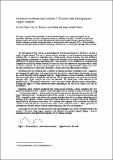Por favor, use este identificador para citar o enlazar a este item:
http://hdl.handle.net/10261/111134COMPARTIR / EXPORTAR:
 SHARE SHARE
 CORE
BASE CORE
BASE
|
|
| Visualizar otros formatos: MARC | Dublin Core | RDF | ORE | MODS | METS | DIDL | DATACITE | |

| Título: | Carbenoid insertions into benzylic C-H bonds with heterogeneous copper catalysts |
Autor: | Fraile, José M. CSIC ORCID ; Mayoral, José A. CSIC ORCID; Muñoz, Ana; Santafé-Valero, Jorge CSIC | Palabras clave: | Carbene insertion Heterogeneous catalysis Copper catalysts Benzylic insertion |
Fecha de publicación: | 2013 | Editor: | Elsevier | Citación: | Tetrahedron 69(35): 7360-7364 (2013) | Resumen: | The copper complexes with bis(oxazoline) or azabis(oxazoline) ligands, once supported on laponite clay by electrostatic interactions, are able to catalyze the insertion of carbenoids in benzylic C-H bonds. In contrast with rhodium catalysts, they are more active with tertiary than with secondary bonds, through a similar mechanism as shown by Hammet correlation. Enantioselectivities are only moderate, with values up to 50% ee. The immobilized catalysts are partially recoverable and the best results are obtained in the case of reactions with high chemoselectivity. © 2013 Elsevier Ltd. All rights reserved. | Versión del editor: | http://dx.doi.org/10.1016/j.tet.2013.06.088 | URI: | http://hdl.handle.net/10261/111134 | DOI: | 10.1016/j.tet.2013.06.088 | Identificadores: | doi: 10.1016/j.tet.2013.06.088 issn: 0040-4020 |
| Aparece en las colecciones: | (ISQCH) Artículos |
Ficheros en este ítem:
| Fichero | Descripción | Tamaño | Formato | |
|---|---|---|---|---|
| Carbenoidinsertionsinto.pdf | 163,05 kB | Adobe PDF |  Visualizar/Abrir |
CORE Recommender
SCOPUSTM
Citations
8
checked on 10-abr-2024
WEB OF SCIENCETM
Citations
7
checked on 25-feb-2024
Page view(s)
341
checked on 19-abr-2024
Download(s)
366
checked on 19-abr-2024
Google ScholarTM
Check
Altmetric
Altmetric
NOTA: Los ítems de Digital.CSIC están protegidos por copyright, con todos los derechos reservados, a menos que se indique lo contrario.
